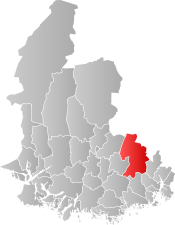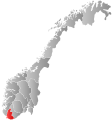Øvrebø og Hægeland
Øvrebø og Hægeland herred | |
|---|---|
 View of one of the local churches, Hægeland Church | |
 Øvrebø og Hægeland within Vest-Agder | |
| Coordinates: 58°17′26″N 07°46′39″E / 58.29056°N 7.77750°ECoordinates: 58°17′26″N 07°46′39″E / 58.29056°N 7.77750°E | |
| Country | Norway |
| County | Vest-Agder |
| District | Sørlandet |
| Established | 1 Jan 1865 |
| • Preceded by | Øvrebø Municipality |
| Disestablished | 1 July 1896 |
| • Succeeded by | Øvrebø and Hægeland municipalities |
| Administrative centre | Øvrebø |
| Area (upon dissolution) | |
| • Total | 303 km2 (117 sq mi) |
| Population (1896) | |
| • Total | 1,731 |
| • Density | 5.7/km2 (15/sq mi) |
| Time zone | UTC+01:00 (CET) |
| • Summer (DST) | UTC+02:00 (CEST) |
| ISO 3166 code | NO-1016 |
Øvrebø og Hægeland is a former municipality that was located in the old Vest-Agder county in Norway. The 303-square-kilometre (117 sq mi) municipality existed from 1865 until its dissolution in 1896. It was located in the northern part of the present-day municipality of Vennesla, to the west of the Otra river.[2][3] The administrative centre of the municipality was the village of Øvrebø, where Øvrebø Church is located.
History
The municipality of Øvrebø og Hægeland was established in 1865 when the old municipality of Øvrebø was divided into Vennesla (population: 1,103) and Øvrebø og Hægeland (population: 1,829). The municipality existed until 1 July 1896, when it was split to create two new municipalities: Øvrebø (population: 888) and Hægeland (population: 843). These two municipalities later merged into Vennesla municipality in 1964.[4]
Name
The municipality is a combination of the names of two parishes: Øvrebø and Hægeland. Øvrebø is named after the old Øvrebø farm (Old Norse: Øfribœr), since the first Øvrebø Church was built there. The first part of the name means "upper" and second part of the name is identical with the word bœr which means "farm" and it is cognate with the Dutch language word "boer" which means "farmer". The name therefore means "the upper farm".[5]
Hægeland is named after the old Hægeland farm (Old Norse: Helgaland). The first element of the name means "holy" (Old Norse: heilagr and Norwegian: hellig) and the last element (Old Norse: land) is identical with the word land which means "land". This area was important to ancient Norse pagan worship.[6][7]
See also
References
- ^ "Forskrift om målvedtak i kommunar og fylkeskommunar" (in Norwegian). Lovdata.no.
- ^ Store norske leksikon. "Hægeland" (in Norwegian). Retrieved 17 January 2017.
- ^ Store norske leksikon. "Øvrebø – tidligere kommune" (in Norwegian). Retrieved 17 January 2017.
- ^ Jukvam, Dag (1999). "Historisk oversikt over endringer i kommune- og fylkesinndelingen" (PDF) (in Norwegian). Statistisk sentralbyrå.
- ^ Rygh, Oluf (1912). Norske gaardnavne: Lister og Mandals amt (in Norwegian) (9 ed.). Kristiania, Norge: W. C. Fabritius & sønners bogtrikkeri. p. 36.
- ^ "Hægeland" (in Norwegian). Store norske leksikon. Retrieved 29 October 2009.
- ^ Rygh, Oluf (1912). Norske gaardnavne: Lister og Mandals amt (in Norwegian) (9 ed.). Kristiania, Norge: W. C. Fabritius & sønners bogtrikkeri. p. 34.
External links
 Vest-Agder travel guide from Wikivoyage
Vest-Agder travel guide from Wikivoyage
- CS1 Norwegian-language sources (no)
- Articles with short description
- Short description with empty Wikidata description
- Coordinates not on Wikidata
- Articles containing Old Norse-language text
- Articles containing Norwegian-language text
- AC with 0 elements
- Use dmy dates from November 2020
- Vennesla
- Former municipalities of Norway
- 1865 establishments in Norway
- 1896 disestablishments in Norway


